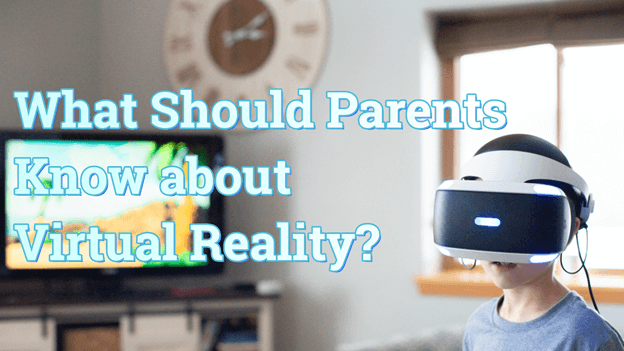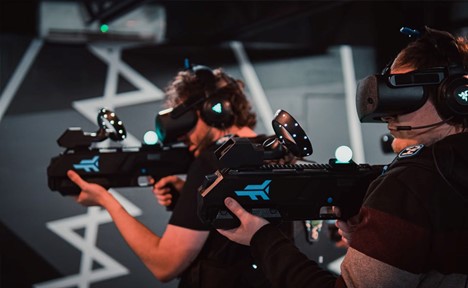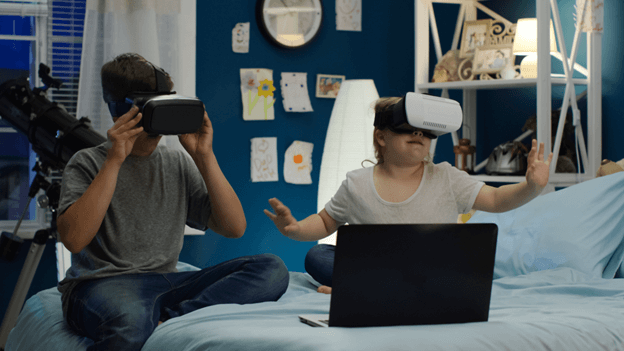Virtual reality (VR) may seem like something out of a sci-fi movie, but it's quickly becoming a reality. And while there are still some kinks to be worked out, VR has the potential to change the way we interact with the world forever.
Only in the past few years has technology caught up with our imaginations. Now, there are VR headsets you can purchase for your home, and businesses are also beginning to adopt VR technology. So far, VR has been used for gaming, but its potential doesn't stop there. With VR, you can hang out with friends in a virtual world, visit incredible locations without leaving your home, and even get training for a new job.

The possibilities are endless with VR, and we are only just beginning to scratch the surface. However, the long-term implications of this rapidly developing technology on kids' health have worried many parents. Is virtual reality safe? Should parents worry about that? Here we will make a profound introduction to virtual reality and introduce its pros and cons to help you judge whether it is safe for your kids or not.
Part 1: What is Virtual Reality?

Virtual reality is a computer-generated environment that allows users to interact with three-dimensional images and simulated worlds. VR is achieved by using a headset, which is connected to a computer or gaming console. The headset covers the user's eyes and uses two small screens to create the illusion of being in another place. Headphones are also often used to create a more immersive experience.
Virtual reality can be used for entertainment, education, and training purposes. However, some people may experience motion sickness or eye strain when using virtual reality. Taking breaks often and starting with short VR sessions is essential.
The most popular VR headset on the market is the Oculus Rift, developed by Facebook. In addition, PlayStation and Xbox have developed VR headsets that operate directly with gaming consoles. Other VR systems may be used with smartphones, and some VR headsets can be connected to a PC. Most VR systems also come with special handheld controllers that allow users to interact with their virtual environment.
Part 2: Is Virtual Reality Safe?
To judge whether virtual reality is safe for kids or not, you can learn about its benefits and drawbacks first.
Pros
Virtual reality has several significant benefits for children that are worth learning about, even if you're not sure if VR is suitable for your family yet. These potential benefits include:
Pro 1. Education:
Virtual reality may be more critical for children's education. Companies like National Geographic have constructed VR settings allowing youngsters to travel virtually across the world. Kids familiar with and comfortable with VR can easily adjust to technology-enabled learning environments. VR may also be helpful in teaching subjects such as spaceflight and exploration.
Pro 2. Physical activity:
Unlike traditional videos where kids are primarily sedentary, VR requires them to use their body and mind simultaneously. So while it's not a replacement for going outside, it can help kids stay active when they can't go outside to play. In addition, virtual reality can improve children's motor skills.
Pro 3. Social skills:
Some parents worry that virtual reality will make kids more isolated, but it can have the opposite effect. VR can be used to teach children how to interact with others in a safe environment. For example, VR can be used to help kids with autism learn social cues and practice interacting with friends. Additionally, virtual reality can help children with social anxiety or autism learn to interact with others.
Pro 4. Promote creativity and inspire imagination:
Because VR games are highly engaging and interactive, they can help kids use their imaginations more. For example, games that allow users to build virtual worlds or design characters can inspire creativity. In addition, virtual reality is great for kids to learn about other cultures and places they otherwise would not be able to experience.
Cons
Con 1. Cyber sickness:
Some people may feel nauseous, dizzy, or have a headache after using VR for an extended period. Taking breaks often and drinking plenty of water when using VR is essential. There's little evidence on how virtual reality may affect sensory development or whether it might exacerbate pre-existing conditions. In any case, VR can lead to eye strain and fatigue for youngsters of all ages.
Con 2. Isolation:
VR can lead to social isolation if not used in moderation. Therefore, it is imperative to encourage kids to take breaks from VR and interact with the real world. Besides, VR can take away the opportunities to explore the outdoors and engage in physical activity.
Con 3. Inappropriate content:
There is a risk that kids will encounter inappropriate content when using VR. Parents should carefully monitor their children's activity and ensure they only access age-appropriate content. Experts are also concerned that predators may soon join these social interactions.
Con 4. Addictive:
VR offers an immersive, sensory experience that can be very addictive. It is important to set limits on VR use and ensure that it does not interfere with other aspects of kids' lives, such as school or social activities. Manufacturers of VR technology and games thus generally recommend their goods to children aged 12–13.

Part 3: Virtual Reality Games for Kids
There are many virtual reality games for kids that parents too can enjoy. Here are some of the most popular VR games that parents can enjoy with kids:
1. Rec Room:
Rec Room is a social VR game that enables people to play games like paintball, charades, Frisbee golf, and even dodgeball in a fun environment. You can meet and interact with other people in the game. The game has a "Dorm Room," where you can design and customize your avatar with clothing, hairstyle, and accessories. The game is exciting and safe, but due to the social element, Rec Room is only available for kids aged 13 years and above.
2. Candy Kingdom VR:
There are a lot of fantastic VR shooters, but the majority of them are too frightening for children and involve killing people, zombies, and monsters. Candy Kingdom VR is an exception and takes shooters into something enjoyable and approachable for everyone in the family. You can still shoot at targets, but they're colorful and not scary at all. The game feels like you're in Disney and looks bright, fun, and colorful.
3. Tilt Brush:

Remember how you first got your computer and couldn't stop using the pre-installed paint program? Tilt Brush takes that same experience and transforms it for today's kids and adults. Tilt Brush is a 3D virtual reality paint program that allows you to create artworks in 3D. Kids can draw items with depth and then scale them up or down, wander around them, erase them, or modify them—whatever you can think of. Traditional brushes are not required. Instead, you may paint using fire, smoke, or neon lights—whatever you feel like.
Part 4: Tips for Parents on Virtual Reality for Kids
Virtual reality has many benefits, but it is essential to use it in moderation. Here are some tips for parents on how to make sure their kids are getting the most out of virtual reality:

Tip 1. Educate yourself:
Before letting your kids use VR, educating yourself on the topic is essential. Learn about the different types of VR and the potential risks involved, which will help you make informed decisions about what is appropriate for your children and what is not.
Tip 2. Set limits:
Once you have educated yourself on virtual reality, you can start setting limits on how much time your children spend using it. Finding a balance between letting your kids explore VR and ensuring they are not spending too much time in a virtual world is crucial.
Tip 3. Monitor content:
As we mentioned before, there is a risk that kids will come across inappropriate content when using VR. Parents should monitor their children's activity and ensure they only access age-appropriate content.
Tip 4. Encourage social interaction:
While VR can be a great way to entertain kids, it is important to encourage them to take breaks and interact with the real world. Make sure they spend time with friends and family and participate in physical activity.
Tip 5. Pay attention to VR headsets:
Some VR headsets are not designed for children and can be uncomfortable or even dangerous for them. Make sure you buy a comfortable headset that fits well and has age-appropriate content.
Part 5: What can Wondershare FamiSafe Do?
Virtual reality can offer an excellent experience for kids, but monitoring their activity and ensuring they are not spending too much time in a virtual world is essential. Wondershare FamiSafe can help you do just that. Wondershare FamiSafe is a parental control app that allows you to track your child's location, set limits on screen time, block inappropriate websites, and more. It also has a feature that will enable you to see what apps your child is using and how much time they spend on each one.
Some of the features that FamiSafe offers include:
1. Limit Screen time: You can limit your child's time on their device each day.
Here is the video showing you how to limit kids' screen time with Wondershare FamiSafe:
2. Block inappropriate websites: You can block access to websites that contain inappropriate content.
3. Track location: You can see where your child is at all times and set up alerts if they leave a particular area.
4. Monitor history: FamiSafe can also help parents keep track of their children's app usage history. They may see which applications are being used by their children and for how long this is occurring.
5. Set restrictions on specific apps and games: Parents may also limit their children's usage of particular applications and games to prevent them from viewing material beyond their age group.
6. Block inappropriate websites and content: FamiSafe can also help parents block access to websites that contain inappropriate content for their children.
Conclusion
Virtual reality is here to stay, and there are many benefits for both children and parents. Instead of labeling a new technology as 'evil', it is essential to educate yourself on the topic, what the dangers are, and set appropriate limits for your children. VR will also be an increasingly large part of your kid's world as they grow up, from remote learning to hanging out with friends. Understanding the technology behind VR and transparent rules for gaming and use will help you give your child the best experience with this new and exciting technology.
